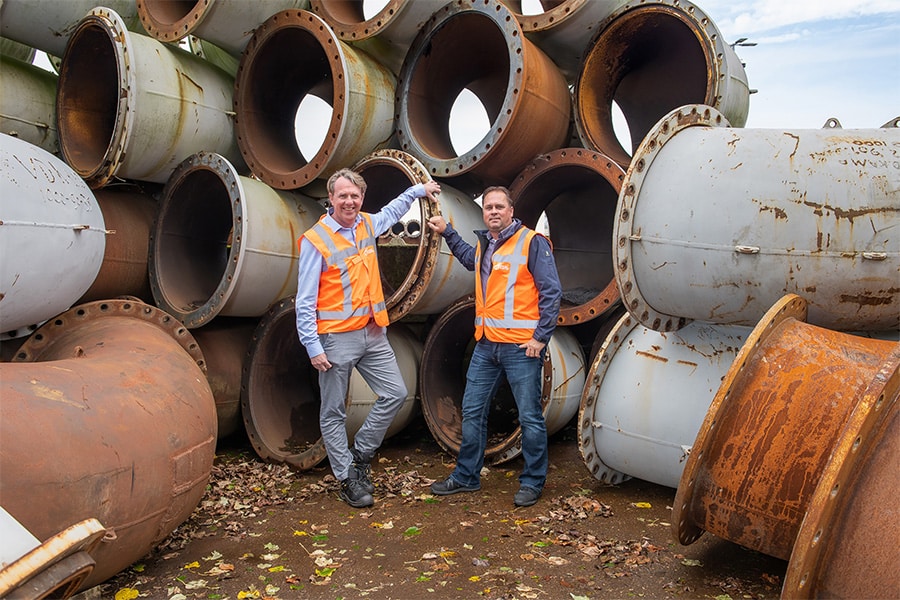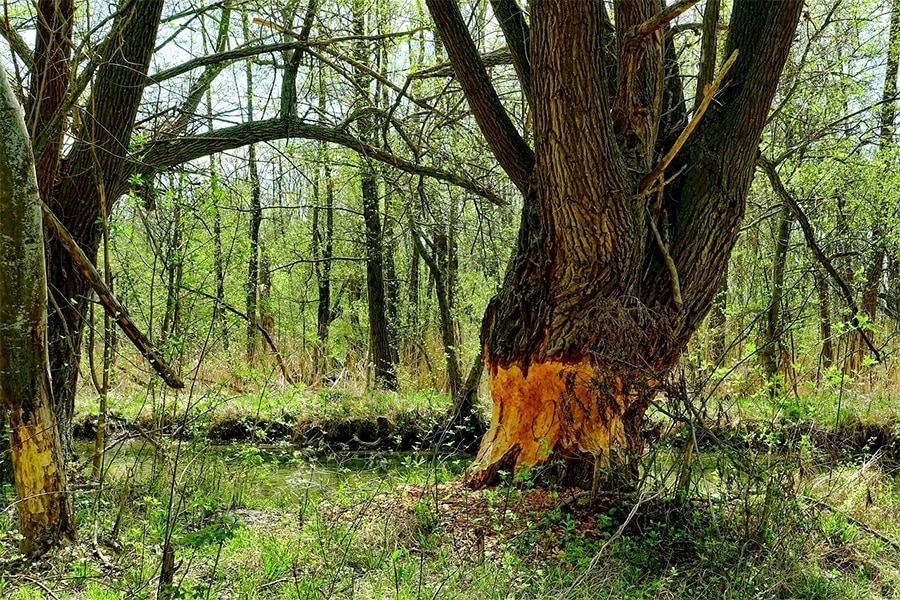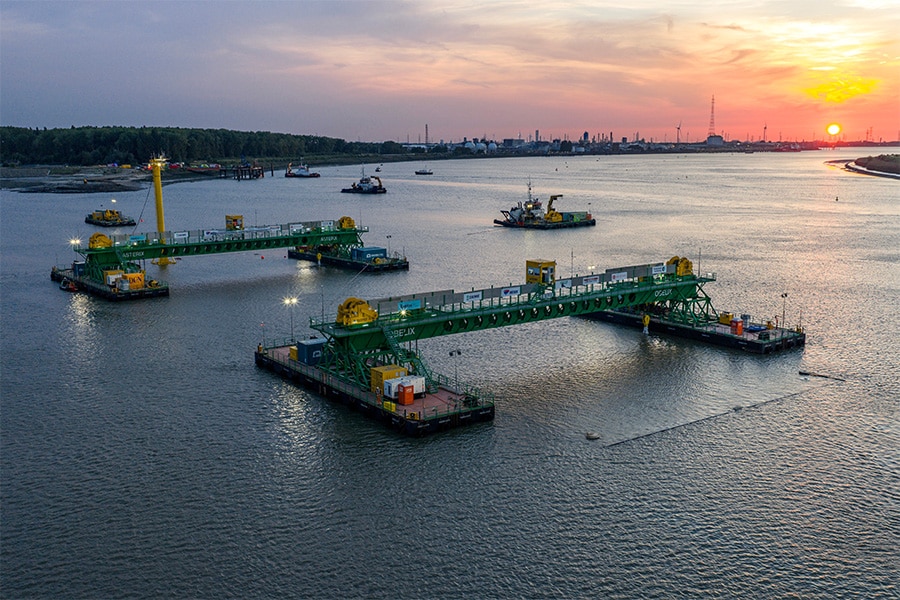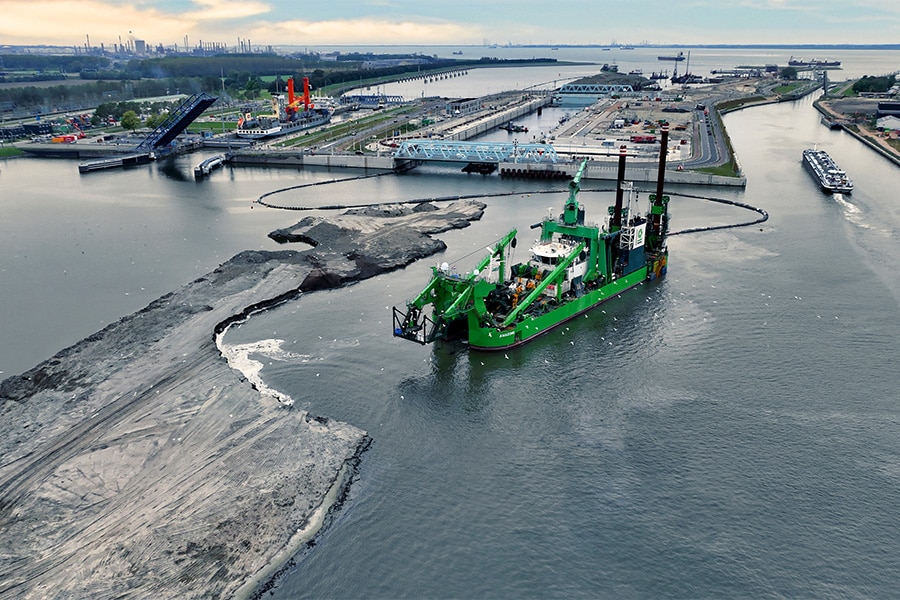
New Terneuzen Lock: how 11.5 million cubic meters of land finds a new use
Friday, Oct. 11, 2024, the New Terneuzen Lock will open. A lock 427 meters long, 55 meters wide and 16.44 meters deep. With this, the lock provides access to the canal from Ghent to Terneuzen for ships that can also pass the new locks in the Panama Canal. A great deal of excavation work has therefore been carried out for this new access over the past six years, totaling some 11.5 million cubic meters. We are going to talk about all this earth moving plus the bank and soil protection in this article.
Before literally and figuratively one shovel went into the ground at the New Terneuzen Lock, a lot of research was done. Because in order to move soil, a lot has to become clear first: what kind of soil is involved, which soil layers are there, is it contaminated or not, are there (archaeological) objects in the ground? "We carried out a lot of research prior to the award," explains Joris de Maat, Soil and Permits consultant with the client Flemish-Dutch Scheldt Commission (VNSC). "For example, we conducted environmental engineering research into the quality of the soil, geotechnical research to determine what soil layers are in this area (think sand, clay and peat) and archaeological and paleontological research. Regarding the latter, tusks and molars of the woolly mammoth, among others, have been found. Research at the University of Groningen has now determined that these remains are 40,000 to 50,000 years old. On the basis of the geotechnical research, a geological model was made in which all the soil layers could be seen. This was very relevant for the placement of the walls of the lock and the pumping out of the construction pits for the inner and outer head, for example. To be able to pump these out, you need to know exactly how the ground is constructed. Based on the model, contractor combination Sassevaart prepared a pumping recommendation." This preliminary investigation, carried out in the period between the contract award and the actual construction of the lock, focused not only on the soil quality but also whether there were any old foundations or other remnants in the ground. "And indeed there were," Joris explains. "Among other things, we came across an old inundation sluice, remnants of an old bridge blown up in World War II by retreating French soldiers and parts of a drainage sluice from the early 1900s. We were able to remove all of this."
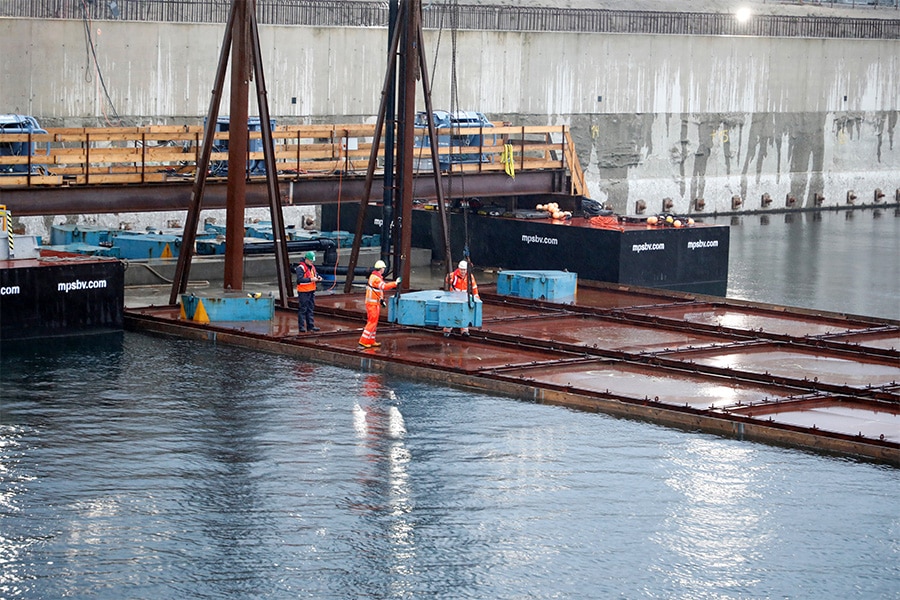
PFAS crisis
During the project, in 2019, PFAS was also detected. This meant a lot of additional research. All alarm bells were ringing, because in June 2019, the Dutch government decided to introduce the Temporary PFAS Handling Framework. This brought a large number of projects to a halt. The adjustment of this Temporary Handling Framework gave more opportunities for land movement. "In a polder near Terneuzen, we were fortunately able to temporarily store some of the released and initially PFAS-suspected soil.
As a result, we were able to prevent the work on the New Terneuzen Lock from coming to a halt, which obviously would have had considerable financial consequences. After the standard was adjusted, we were still able to store the dredged material containing PFAS in the Rijkswaterstaat depot in the Hollandsch Diep."
Ground Flow Plan
The soil released from all the dredging also has to go somewhere. To determine where what soil can go, a soil flow plan was created. "The quality of the soil determines where it goes. In the soil flow plan, we included everything: type of soil, the quality of the soil, the necessary permits, what timing are we talking about and what volumes are involved," explains Jori van der Hout, consultant at Sassevaart. "The entire New Lock project area was mapped and divided into four streams based on environmental health quality: industrial, residential, agricultural/natural and non-applicable. In total, 11.5 million cubic meters of soil were moved. Of this, 5.2 million cubic meters is under certificate BRL 9335-2. This is a certificate for clean soil. We are audited twice a year by Kiwa. Soil in the residential and industrial classes has been transported to Golfbaan Oostburg, the clean soil agricultural/natural to Biervliet and the non-applicable soil has been transported to approved processors such as ATM Moerdijk and Grondreinigingscombinatie Nauerna." The remaining soil, just under 6 million cubic meters and mainly soil from dredging that was released during the work at the port, falls under the BRL 9335-2 and has been usefully applied in the Westerschelde as a foreshore replenishment and at Knokke and a number of projects in Zeeuws-Vlaanderen. In a project as large as the Nieuwe Sluis Terneuzen project, it is not always possible to immediately find a final destination for released soil. The sand that could not be directly reused within the project was temporarily stored on the site in a polder near Terneuzen.
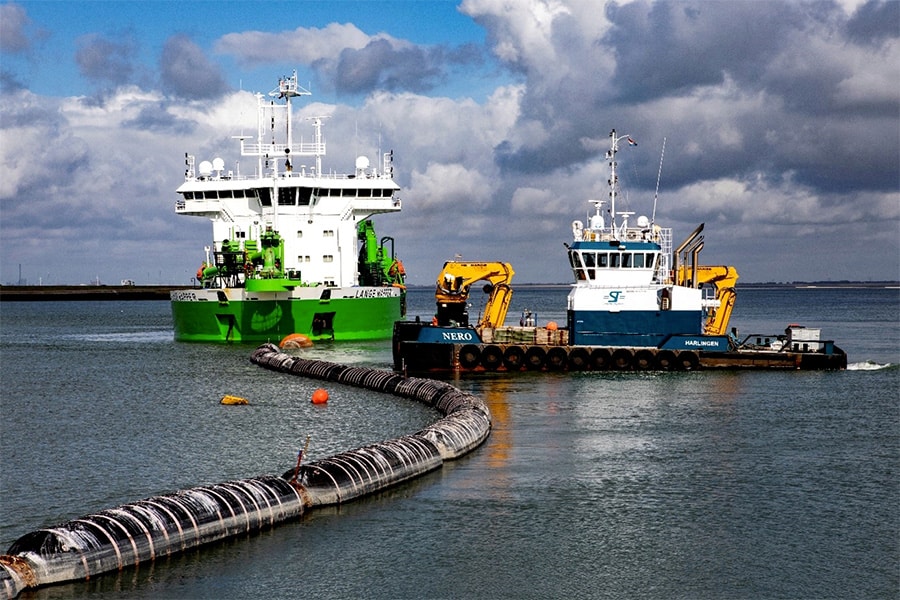
Inspections
Normally, soil is inspected per 6,000 cubic meters. In the case of the New Terneuzen Lock, the volume is such, over 5 million cubic meters to be removed, that it is impractical to inspect every 6,000 cubic meters. "We therefore started with five inspections within the framework of the soil from projects permit examination (BRL-9335). Based on these five, we looked for any differences/discrepancies. Based on this, we determined how many additional inspections were still needed on the 5 million cubic meters. In the end, in line with the BRL, we performed about twenty inspections in total."
Soil protection desperately needed
While a lot of earth moving took place, a lot of hard work was also done to protect the bottom and banks of the area from possible erosion. Because with the arrival of the New Lock, larger ocean-going vessels will be able to pass through the lock. The lock can accommodate ships up to 366 meters long, 49 meters wide and 14.5 meters deep. Larger ships also mean more wave action and currents from propeller blasts (caused by a ship's (bow) propeller) which can put a great strain on the bank and bottom. Add to that the tide and the spray flow through the lock, and you can imagine that the bottom and the banks have a lot to endure. To prevent erosion and thus damage, bottom and bank protection has been installed.
Load determines type of protection
"To determine which type of protection goes where, the normative load is considered," explains Vyasa Sewberath-Misser, Hydraulic Engineering Advisor at VNSC. "Because the outer and inner harbor of the Nieuwe Sluis Terneuzen have quite a large surface area and the loads are not the same everywhere, the work area is divided into compartments. Based on the normative load, Sassevaart makes the design for the bottom protection. The VNSC client specified the preconditions that the design had to meet. For example, the soil protection must be low-maintenance and requirements have been set regarding the maximum damage that may occur as a result of the normative loads (Damage Parameters Granular Soil Protection)."
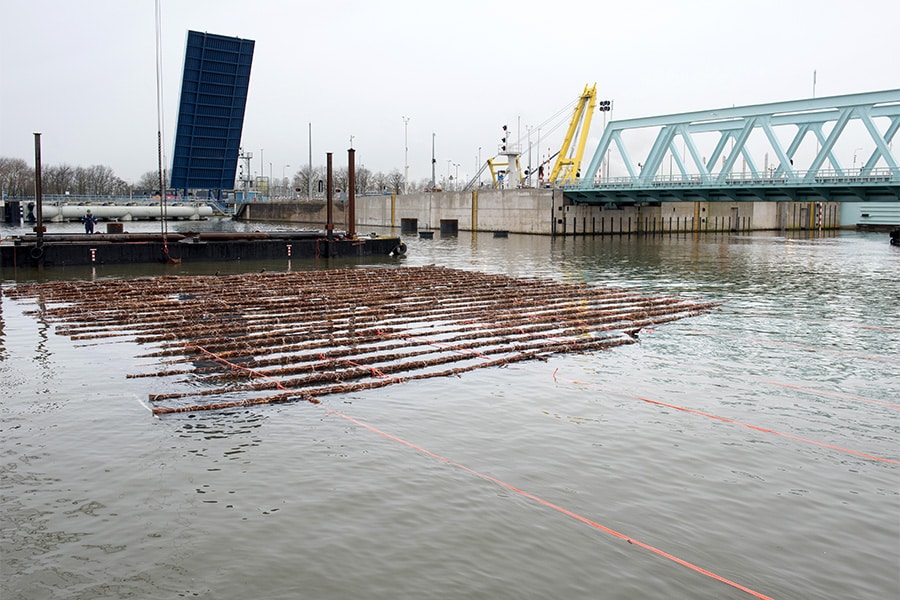
Work plan and on-site monitoring
After determining the type of soil protection needed, Sassevaart draws up a work plan. This describes how they will install the soil protection. "Even during the work, we keep an eye on whether everything goes according to plan," Vyasa explains. "Together with my colleagues, I then look at the landfill stones: do they meet the requirements in terms of mass distribution and length-to-width ratio. Sometimes we also have stone inspections done by an external party. Most of the stones come from Belgian quarries. Before, during and after the application of the various layers of soil protection, Sassevaart conducts soundings. Once the soil protection has been completed, we receive these soundings and use ArcGIS to create difference maps to check the thickness of the various layers of soil protection. I also check whether the top of the soil protection is below or at the contractually agreed depth."
Grids of willow pine
Evelyn de Clerq is part of Sassevaart's Soil and Dredging team and in this role is responsible for all soil and bank protection. Making the zinc pieces on the zate is largely manual work and requires a lot of time. "In terms of protection, we work with sinkers with geotextiles. The cloths are delivered to size. The geotextile is tied on the zate to a framework of willow. You can think of it as a kind of grid of geotextile with willow twigs. The zinc pieces vary in size, the largest being about 60 feet by 20 feet. These zinc pieces are placed side by side with about a meter overlap. Based on the execution design, the sinker configuration is drawn out."
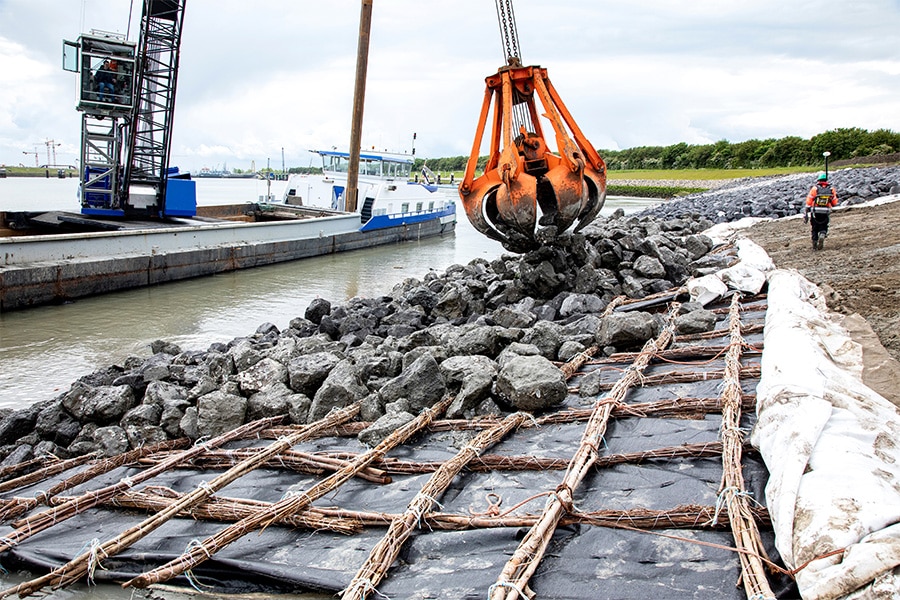
Sinking piece by piece
Applying the bottom protection is quite a job. A crane ship lays the mats floating in the water, using GPS to determine the correct position. Then it is partly sunk with rock. Afterwards, a survey is carried out to determine whether the mat is indeed in the correct position. If so, the next mat is sunk with an overlap of one meter. Then the mats are poured with the remaining crushed stone. To give sufficient strength to the structure, it is usually penetrated with colloidal concrete. This creates a layer of crushed stone where the hollow spaces between the stones are filled with concrete. This is special concrete to which substances have been added to allow it to be processed underwater. "In the tidal zones, we apply cast asphalt because it is less sensitive to washout by waves. The poured stones also vary in size. We mainly use two grades in the project: 5-40 kilograms and 40-200 kilograms. We apply the latter mainly in areas where the load due to waves and currents is greater."
Opening of New Lock Terneuzen
Friday, Oct. 11 marks the opening of the New Terneuzen Lock. After a long period of construction starting in late 2017, more and larger vessels will finally be able to pass through the canal as far as the port of Ghent. It also increases the capacity and reliability of the locks, which also reduces the waiting time for inland vessels. This makes the New Terneuzen Lock ready for the next hundred years. A milestone that everyone involved is very much looking forward to. The final work and the opening can be followed on www.nieuwesluisterneuzen.eu.
